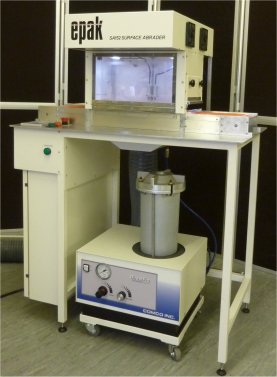Surface Abrader - SA152 Precision Micro Abrasive Surface Abrader - NEW
 The Epak Electronics Ltd SA152 Precision Surface Abrader will abrasively clean or texture thin flat parts up to 170mm wide, 320mm long and up to 20mm thick. The system includes either a Comco DF1400 Directflo or Comco PF2400 Powerflo abrasive blaster that sits underneath the machine on a wheeled trolley. On the underside of the main blast chamber is an extract port for connecting to a suitable dust extractor.
The Epak SA152 Precision Surface Abrader improves on the original SA150 Surface Abrader design by swapping the linear motor for a belt driven mechanism, increasing the size of the blast chamber, swapping the rear abrasive exhaust vent to a downdraught table type extract and also by improving the PLC functions and features and lastly by making the design scalable to accommodate larger wafers.
The Epak Electronics Ltd SA152 Precision Surface Abrader will abrasively clean or texture thin flat parts up to 170mm wide, 320mm long and up to 20mm thick. The system includes either a Comco DF1400 Directflo or Comco PF2400 Powerflo abrasive blaster that sits underneath the machine on a wheeled trolley. On the underside of the main blast chamber is an extract port for connecting to a suitable dust extractor.
The Epak SA152 Precision Surface Abrader improves on the original SA150 Surface Abrader design by swapping the linear motor for a belt driven mechanism, increasing the size of the blast chamber, swapping the rear abrasive exhaust vent to a downdraught table type extract and also by improving the PLC functions and features and lastly by making the design scalable to accommodate larger wafers.
 The standard machine occupies a floor area approximately 1005mm x 620mm x1360mm high. The conveyor height is 970mm from the floor. The overall conveyor is 930mm x 190mm wide. Thirteen abrasion resistant polyurethane belts make up the conveyor belt.
The abrasive blast area is enclosed so that very little dust will escape with the correct extraction flow. The chamber is illuminated and has a large front window/door so the operator may view the part being processed. The blast chamber door allows full access to the head for setting the height of the blast nozzles. As standard, the machine comes fitted with two nozzles, however, we are able to offer single nozzle and triple nozzle heads if needed.
The standard machine occupies a floor area approximately 1005mm x 620mm x1360mm high. The conveyor height is 970mm from the floor. The overall conveyor is 930mm x 190mm wide. Thirteen abrasion resistant polyurethane belts make up the conveyor belt.
The abrasive blast area is enclosed so that very little dust will escape with the correct extraction flow. The chamber is illuminated and has a large front window/door so the operator may view the part being processed. The blast chamber door allows full access to the head for setting the height of the blast nozzles. As standard, the machine comes fitted with two nozzles, however, we are able to offer single nozzle and triple nozzle heads if needed.
 The blast chamber is fitted with two low voltage LED lamps to aid visibility during use of the machine.
The control panel on the left hand side allows the user to change the process parameters.
Parts are placed on the conveyor belt aligned with the white start indicator bar on the left hand side of the machine. Parameters for blast width, blast length, blast speed, the number of passes across the part before indexing the conveyor, the index distance between passes, and the cycle reprocess steps, can all be changed via the SA152 control panel.
The automatic conveyor belt passes through the blast chamber, underneath the blast nozzle(s). The forwards/backwards motion is controlled by the blast head speed and blast width parameters within the settings. Left to right motion is pre-determined for the conveyor speed.
Adjustable brushed side plates allow for larger components to be passed through the machine and to allow adjustment on the extraction airflow.
Safety interlocks prevent the machine from being run when there is no dust extraction present, or when the protective blast chamber is open. Whilst abrasive blasting is in progress, if there is a drop in pressure or extraction or if the blast cabinet is opened, the SA152 will stop the cycle to prevent any damage or danger to the parts being processed.
The entire nozzle drive mechanism is mounted above the blast chamber and brushes mounted on the top of the blast cabinet help to prevent abrasive powder from entering the top enclosure. There are filtered air vents on the top enclosure to encourage airflow down through the brushes to further allow airflow into the blast chamber.
The ends of the conveyors have clear acrylic guards to prevent the risk of injury to the operators hands and fingers from becoming trapped at the ends of the conveyors.
The whole system requires clean, dry air. A 230v, 50Hz power supply for the SA152 is required. The DF1400-2CE is powered directly from a special socket on the SA152. The Filtex FX50H dust extractor requires a separate 400v, 3 phase power supply and for the control box to be mounted at a convenient location near the dust extractor.
The machine is fitted with an RFI filter on the power inlet.
The blast chamber is fitted with two low voltage LED lamps to aid visibility during use of the machine.
The control panel on the left hand side allows the user to change the process parameters.
Parts are placed on the conveyor belt aligned with the white start indicator bar on the left hand side of the machine. Parameters for blast width, blast length, blast speed, the number of passes across the part before indexing the conveyor, the index distance between passes, and the cycle reprocess steps, can all be changed via the SA152 control panel.
The automatic conveyor belt passes through the blast chamber, underneath the blast nozzle(s). The forwards/backwards motion is controlled by the blast head speed and blast width parameters within the settings. Left to right motion is pre-determined for the conveyor speed.
Adjustable brushed side plates allow for larger components to be passed through the machine and to allow adjustment on the extraction airflow.
Safety interlocks prevent the machine from being run when there is no dust extraction present, or when the protective blast chamber is open. Whilst abrasive blasting is in progress, if there is a drop in pressure or extraction or if the blast cabinet is opened, the SA152 will stop the cycle to prevent any damage or danger to the parts being processed.
The entire nozzle drive mechanism is mounted above the blast chamber and brushes mounted on the top of the blast cabinet help to prevent abrasive powder from entering the top enclosure. There are filtered air vents on the top enclosure to encourage airflow down through the brushes to further allow airflow into the blast chamber.
The ends of the conveyors have clear acrylic guards to prevent the risk of injury to the operators hands and fingers from becoming trapped at the ends of the conveyors.
The whole system requires clean, dry air. A 230v, 50Hz power supply for the SA152 is required. The DF1400-2CE is powered directly from a special socket on the SA152. The Filtex FX50H dust extractor requires a separate 400v, 3 phase power supply and for the control box to be mounted at a convenient location near the dust extractor.
The machine is fitted with an RFI filter on the power inlet.
Glass Wafer processed using SA150 to create blind hole pattern in surface

(close up) Glass Wafer processed using SA150 to create blind hole pattern in surface

Glass Wafer processed using SA150 to create thru hole pattern in surface

(close up) Glass Wafer processed using SA150 to create thru hole pattern in surface

Part Number - Epak SA152 Surface Abrader System

MORE ABOUT MICROBLASTING & EPAK CUSTOM EQUIPMENT:
 ABRASIVE MICROBLASTERS ABRASIVE MICROBLASTERS
|
 EPAK CUSTOM EQUIPMENT EPAK CUSTOM EQUIPMENT
|
|---|
